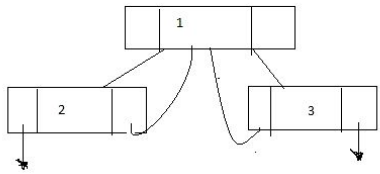Data Structure MCQ - Threaded Binary Tree
Q1.What is a threaded binary tree traversal?
- a binary tree traversal using stacks
- a binary tree traversal using queues
- a binary tree traversal using stacks and queues
- a binary tree traversal without using stacks and queues
Answer:- (d).
Explanations :This type of tree traversal will not use stack or queue.
Explanations :This type of tree traversal will not use stack or queue.
- there are many pointers which are null and thus useless
- there is no traversal which is efficient
- complexity in implementing
- improper traversals
Answer:- (A).
Explanations :As there are majority of pointers with null value going wasted we use threaded binary trees.
Explanations :As there are majority of pointers with null value going wasted we use threaded binary trees.

- it has dangling pointers
- nothing inefficient
- incorrect threaded tree
- space is being used more
Answer:- (A).
Explanations :The nodes extreme left and right are pointing to nothing which could be also used efficiently.
Explanations :The nodes extreme left and right are pointing to nothing which could be also used efficiently.
- inorder, postorder, preorder traversals
- inorder
- postorder
- preorder
Answer:- (A).
Explanations :In threaded binary trees, the null left pointer points to the predecessor and the right null pointer point to the successor. In threaded binary trees, we can use in-order, preorder and postorder traversals to visit every node in the tree.
Explanations :In threaded binary trees, the null left pointer points to the predecessor and the right null pointer point to the successor. In threaded binary trees, we can use in-order, preorder and postorder traversals to visit every node in the tree.
- there are many pointers which are null and thus useless
- there is no traversal which is efficient
- complexity in implementing
- improper traversals
Answer:- (A).
Explanations :As there are majority of pointers with null value going wasted we use threaded binary trees.
Explanations :As there are majority of pointers with null value going wasted we use threaded binary trees.
- 2h-1-1
- 2h+1-1
- 2h+1
- 2h-1+1
Answer:- (B).
- n
- n+1
- 2n
- 2n + 1
Answer:- (B).
- 2, 252, 401, 398, 330, 344, 397, 363
- 924, 220, 911, 244, 898, 258, 362, 363
- 925, 202, 911, 240, 912, 245, 258, 363
- 2, 399, 387, 219, 266, 382, 381, 278, 363
Answer:- (C).
- In-order predecessor
- In-order successor
- Pre-order predecessor
- None
Answer:- (B).
- inorder, postorder, preorder traversals
- inorder
- postorder
- preorder
Answer:- (A).
Explanations :Those are the three representations of binary threaded trees
Explanations :Those are the three representations of binary threaded trees
Copyright © 2022 Shineskill Software Pvt. Ltd., All rights reserved.
